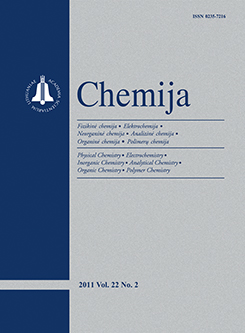Chemija / Chemistry
WHAT?
 ISSN 0235-7216 ISSN 2424-4538 (online) |
2016 m. Nr. 1 Coupling of capillary electrophoresis with reaction detection for on-line determination of radical scavenging activity
Chemical antioxidant activity assays can be classified into batch and separation-based antioxidant activity assays. Batch antioxidant activity assays measure the antioxidant compound ability to quench free radicals by a mixture of antioxidants. Batch methods are quantitative and do not provide information about individual compounds in a sample. Separation-based methods coupled with chemical antioxidant activity assays provide a possibility of the high resolution screening of individual antioxidants in the complex matrices. Capillary electrophoresis is a micro-method based on analyte separation according to the mass-to-charge ratio in a short time with high separation efficiency. Capillary electrophoresis coupled with the post-column radical scavenging reaction detection method can be applied for analysis of antioxidants and evaluation of their radical scavenging activity. In this study an interface for capillary electrophoresis coupling with radical scavenging detection was created using chromatographic components which are readily available in the laboratory. Two set-ups of the interface were tested. For the first set-up a ground electrode was inserted into the reagent vessel to close the electrical circuit before the reaction detector. In this case exclusively hydrostatic pressure was used for reaction mixture delivery through the reaction coil to the reaction detector. The second set-up was created grounding the outlet vial after the reaction detector. In this case high voltage and internal pressure was applied to the separation capillary and reaction coil for the separation of analytes and delivery of the reaction mixture to the reaction detector. For optimization of the reactants mixing ratio different values of hydrostatic pressure and high voltage were tested for both set-ups. The most effective mixing of the reactants is when the flow rate in the CE separation capillary is equal to the flow rate of the reagent solution into the reaction coil. Capillary electrophoresis coupled with radical scavenging reaction detection showed good linearity (R2) (0.996 and 0.993) and repeatability (RSD 3.21 and 5.87%) for the CE detector and the reaction detector, respectively.
: Keywords: capillary electrophoresis, reaction detection, 2,2-diphenyl-1-picrylhydrazyl, radical scavenging activity, polyphenolic compounds |
Issues:
2017 - Vol.28 No. 1, No. 2, No. 3, No. 4 2016 - Vol.27 No. 1, No. 2, No. 3, No. 4 2015 - Vol.26 No. 1, No. 2, No. 3, No. 4 2014 - Vol.25 No. 1, No. 2, No. 3, No. 4 2013 - Vol.24 No. 1, No. 2, No. 3, No. 4 2012 - Vol.23 No. 1, No. 2, No. 3, No. 4 2011 - Vol.22 No. 1, No. 2, No. 3, No. 4 2010 - Vol.21 No. 1, No. 2-4 2009 - Vol.20 No. 1, No. 2, No. 3, No. 4 2008 - Vol.19 No. 1, No. 2, No. 3-4 2007 - Vol.18 No. 1, No. 2, No. 3, No. 4 2006 - Vol.17 No. 1, No. 2-3, No. 4 2005 - Vol.16 No. 1, No. 2, No. 3-4 2004 - Vol.15 No. 1, No. 2, No. 3, No. 4 2003 - Vol.14 No. 1, No. 2, No. 3, No. 4 2002 - Vol.13 No. 1, No. 2, No. 3, No. 4 2001 - Vol.12 No. 1, No. 2, No. 3, No. 4 |